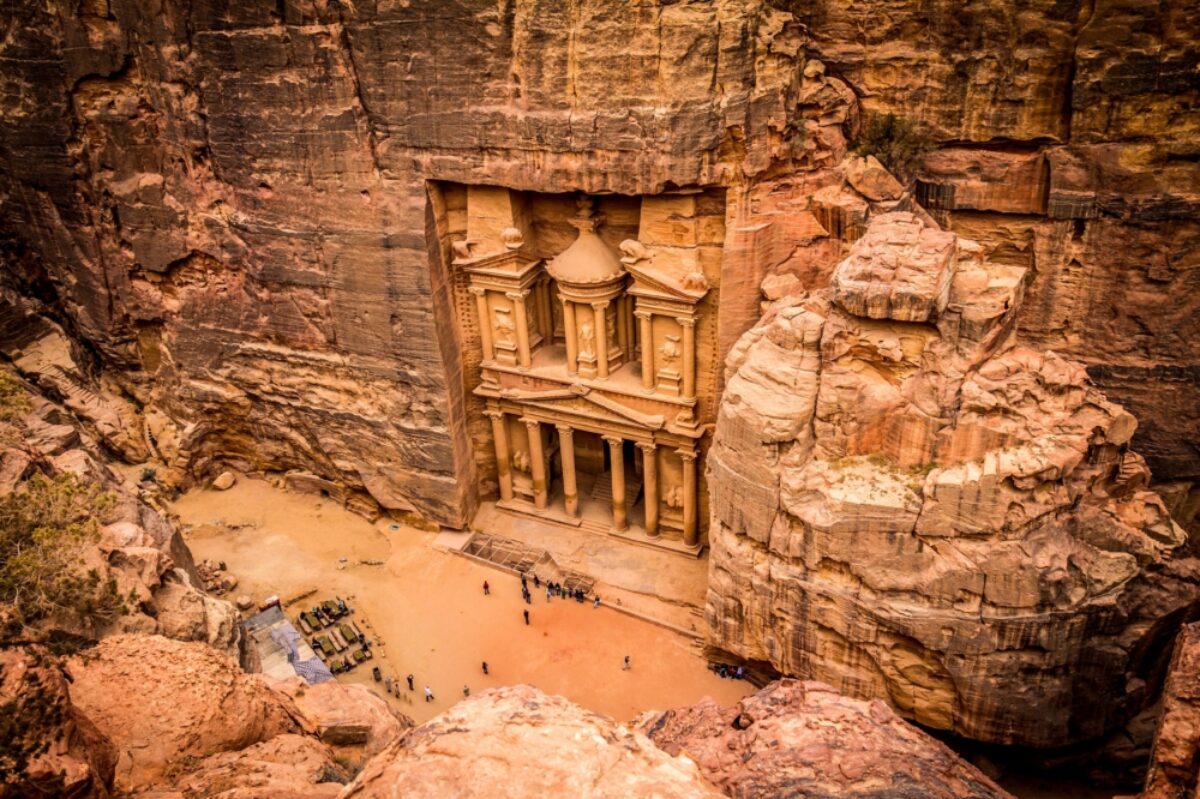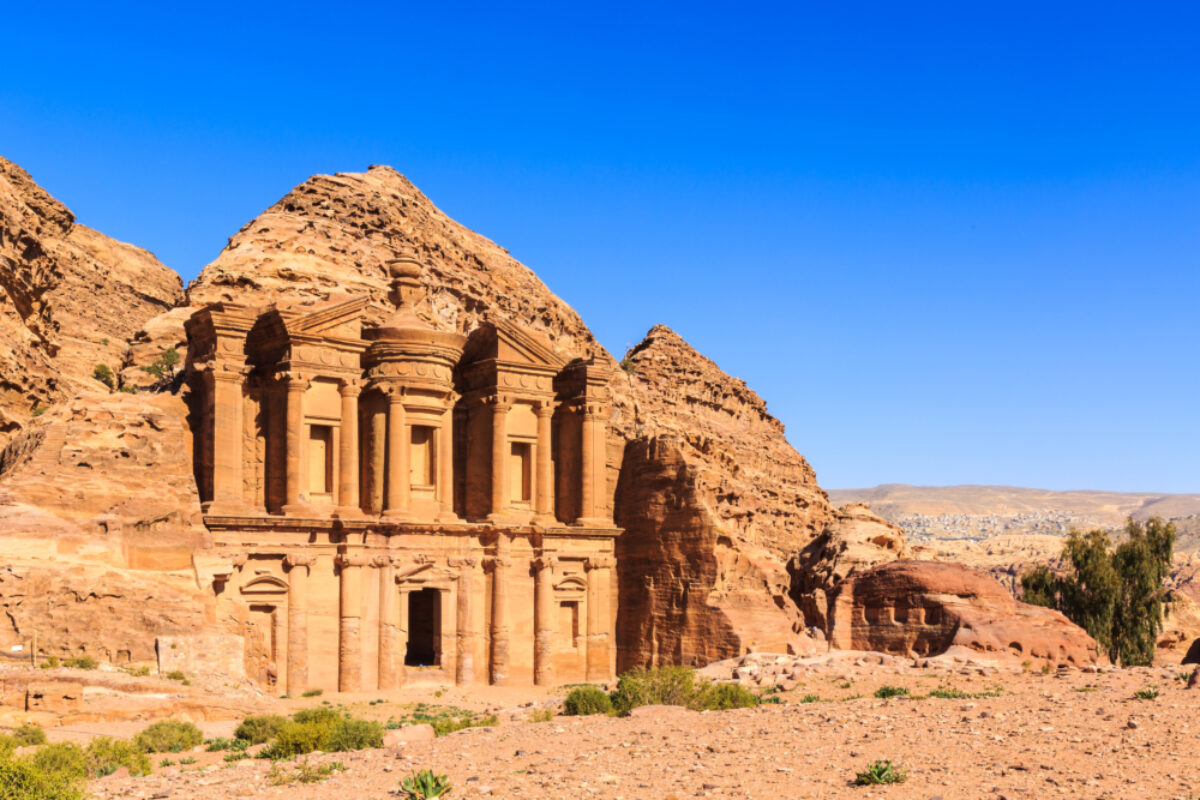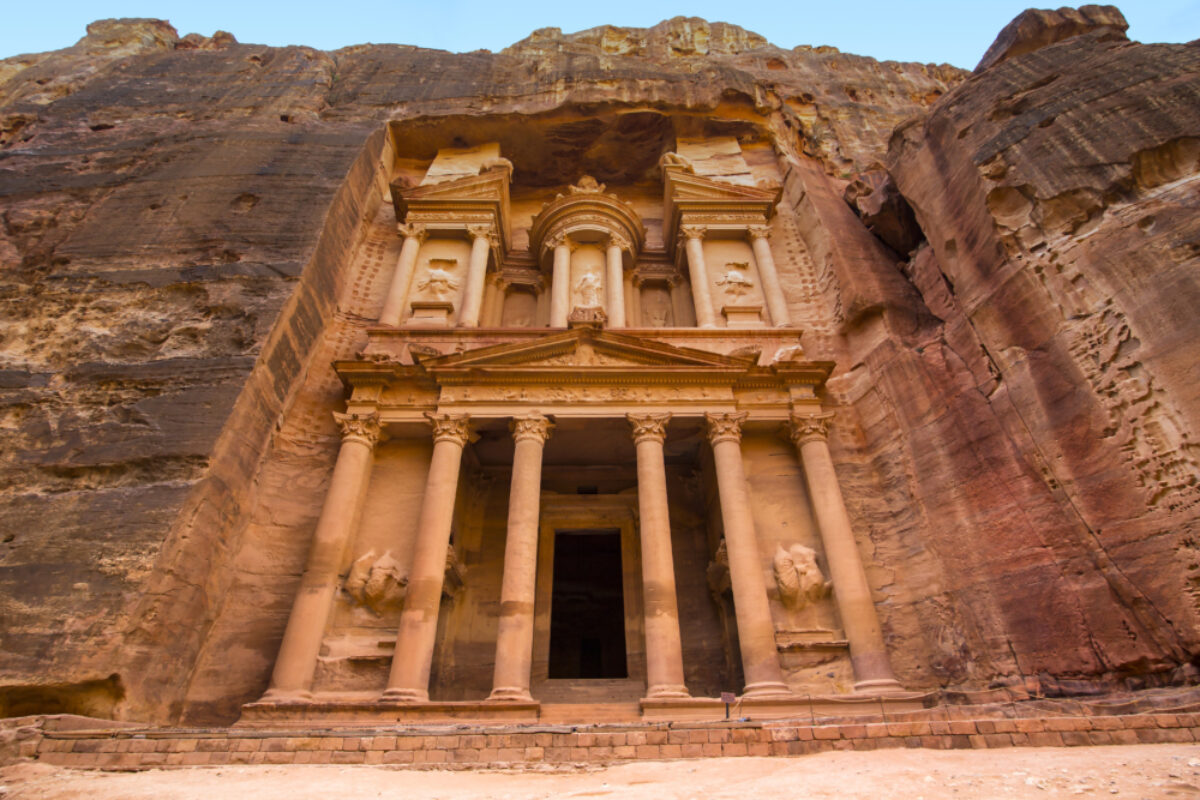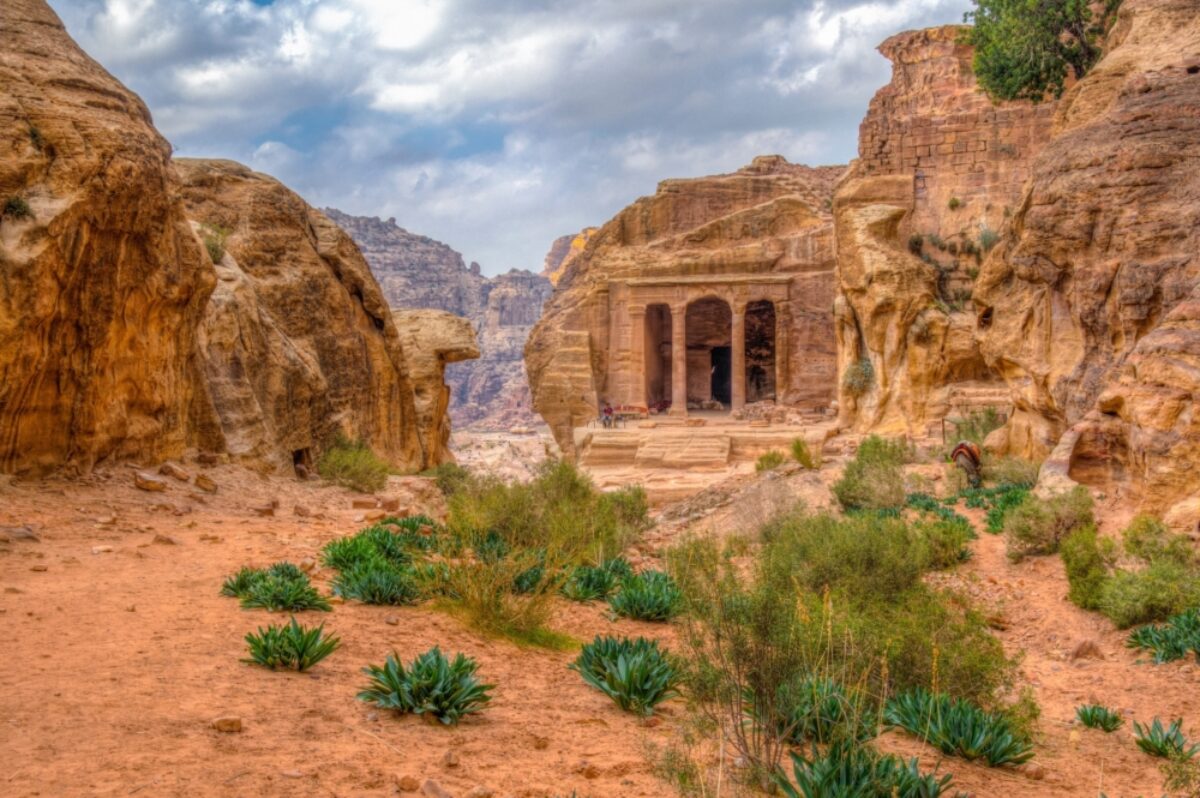How to visit Petra
Exploring the jewel of Jordan
A brief history of Petra
It’s hard to imagine with the huge number of travellers who visit Petra today that it was once nearly erased from memory. The ‘lost city’ of Petra is the most evocative memory left by the ancient Nabateans, a prosperous society of traders and merchants that controlled caravan routes through this part of the Arabian desert and nearby oases. From their accumulating trading wealth, the Nabateans, who were highly-skilled sculptors and engineers, carved a series of incredible structures straight into the sandstone canyon walls around the 1st century BC. A few centuries later, the Romans took over the area and added their own architectural features, such as a looming triumphal gate dedicated to the ruling emperor and a column-lined main thoroughfare.

View from above of Al-Khazneh "the Treasury"
Earthquakes and shifting trade routes that bypassed the city entirely ushered in Petra’s decline in the 4th century AD, though the Byzantines continued to construct churches, some of which are now being excavated. Another earthquake in 551 saw Petra crumble into an obscure backwater; passing nomadic shepherds used the abandoned city for shelter for hundreds of years.
Though Petra has always been known to the local Bedouin – many of whom lived in caves and tombs on the site for generations – the ancient city was rediscovered for the West in 1812 by Swiss explorer Johann Ludwig Burckhardt, who disguised himself as a Muslim to gain access. Western archaeologists, Orientalist artists, adventure seekers and treasure hunters soon arrived, and Petra now sees nearly one million visitors each year.
How to get to Petra
The main entrance to the site is near the Petra Visitor Centre in the town of Wadi Musa, where most travellers stay during their trip. Tickets can be purchased just before the turnstiles with prices depending on how long you want to stay in the site: one day costs 50JD, two days 55JD and three days 60JD. However, the best option is to purchase a Jordan Pass before you arrive, as this scheme includes the visa required to enter the country as well as queue-jumping entrance to Petra and 39 other archaeological sites around the country.
Petra is a vast site that covers some 264 sq/km, so comfortable walking shoes are essential. In a day, you can visit most of the tombs that line both sides of the main street, but to experience the quieter and off-the-beaten track areas of Petra, plan to spend at least an additional day or two.

Ad Deir "the Monastery"
Most of Petra’s monuments lie along the well-trodden Street of Facades and Colonnaded Street, so it’s easy to venture off this track and find a more peaceful Petra away from the crowds.
Unbelievable Treasury views from the Al Khubtha Trail
The immaculate Treasury, Petra’s most iconic structure, is breathtaking from ground level, but for an incredible eagle-eye perspective, head to the Royal Tombs and look for the signs labelled with the trail name that point to the stairs. This 3.5km hike is short but steep and the stairs can seem never-ending. Fortunately, you can catch your breath with panoramic views high above the Theatre and the tourist-thronged Street of Facades along the way. At the top, the ever-entrepreneurial Bedouin have set up tea tents at some of the best viewpoints, so bring along some 1JD notes and have a mint tea with a view that you’ll never forget.
Enter Petra through the hidden ‘back door’
The well-known main way into Petra is through the winding slot canyon called the Siq, but at the other end of this vast site is a little-visited ‘backdoor’ entrance, which curves around the mountainsides and drops hikers near the Monastery. If you can get to this back entrance early enough, you’ll likely have the Monastery all to yourself, as other travellers are huffing and puffing up the 850 hand-carved sandstone stairs to get here. This back door path is one of the most popular sections of the Jordan Trail, which runs from a nature reserve at Dana to this secret entrance. It’s one of the most remarkable ways to experience Petra from a different perspective. There are no facilities at this back entrance, so you must have a ticket to the site before you arrive.
Explore the tombs of Wadi Farasa and the High Place of Sacrifice
Just behind Petra’s main valley is another collection of stunning but hardly visited tombs. To find the trail, follow the path that goes up the stairs behind the Temple of Dushara, Petra’s largest freestanding building. The trail then meanders through a shrub-speckled rocky valley before arriving at the Broken Pediment Tomb and the water-worn Renaissance Tomb. Nearby, the imposing Tomb of the Roman Soldier and the columned façade of the Garden Temple show the architectural influence of the ancient Roman Empire on this area. Though the exteriors in this valley are not as well preserved as the Treasury and the Monastery, the tombs are a delight to visit because they see so much less footfall and are open for exploring inside, where waves of colours in the rocks wash across the smoke-darkened interiors. After Wadi Farasa, this trail carries on to the High Place of Sacrifice, a lofty viewpoint where the Nabateans chiselled small bowls and channels into the rock to drain the blood of sacrificial animals.
This path is not marked, and few of the tombs have signage or further information, so hiring a local Bedouin guide will help you get the most out of this hike. Most travellers tackle the High Place of Sacrifice first, but the gentler ascent starting in Wadi Farasa is kinder on the legs.
Little Petra
Thought to be an ancient suburb of Petra, Little Petra is worth a visit in its own right and sees just a fraction of the visitor numbers as the main site. The path through the valley is only about 500m long but is also part of the Jordan Trail, and it’s possible to hike from here to Petra’s back door. Don’t miss Little Petra’s Painted House, which has a fresco ceiling painted with remarkably preserved looping vines of ivy and grape leaves, winged cherubs and colourful birds – all symbols of Dionysus, the ancient Greek god of wine.

View from the entrance of Al-Khazneh "the Treasury"
How to visit Petra responsibly
Petra has withstood sandstone-eroding rains and invading empires for two millennia, but today one of the biggest threats to Petra’s preservation is the rapidly increasing number of visitors. It’s imperative for travellers to be aware of how to lessen their impact on the site. Before you arrive in Jordan, invest in a multi-litre water bladder so you’re not reliant on small plastic bottles. Wear comfortable shoes, but make sure the tread isn’t so abrasive that it digs into the fragile and easily loosened sandstone. Similarly, leave the hiking poles at home, as these easily chip away at the Nabatean-carved stairs. The obviously responsible travel tenets of taking any rubbish out with you and not touching the monuments hold especially true at Petra, though unfortunately, it appears that not all travellers adhere to them.
Though the treatment of the working camels, horses and donkeys in Petra has improved in recent years and many Bedouin handlers are sensitive to visitors’ concerns, incidents of animal abuse, unfortunately, do still occur. Travellers can do their part in protecting the welfare of Petra’s animals by understanding their own physical abilities and setting a good sightseeing pace. If you do decide on a ride, ensure that the animal looks healthy and can carry your weight. Use the services of an adult handler, not a child. While many goods and services are up for negotiation in Jordan, avoid bargaining on a ride so that the provider doesn’t feel pushed to rush the animal to recoup a lost fare; prices are posted at the Petra Visitor Centre.

Located along the Wadi Al Farasa processional route is the Garden Hall




